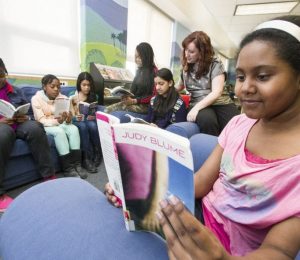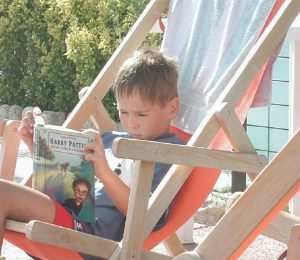When my son was eight, he was obsessed with Harry Potter. He dressed up as the boy wizard for Halloween, he bought any Harry Potter Lego he could get his hands on, and we read all the books together in six months. But when we finished the series, he washed his hands of reading anything else ever again.
This was not good.
For the next two years, though he would listen in on stories I read to his sister, he had no desire to find another book that might really interest him. Then Eleanor LeFave at Mabel’s Fables children’s bookstore in Toronto suggested Peter Nimble and His Fantastic Eyes by Jonathan Auxier. The result was nothing short of a miracle. Hearing him beg for “just one more chapter” every night was the most beautiful sound in the world.
My now 10-year-old is still not a reader. And he still claims to hate reading (we read together as he refuses to read on his own). But a few strategies got him over that Harry Potter hump. Hopefully, they’ll work with your reluctant reader, too.
1. Look for themes they love.
“Find books that are the same but different,” suggests Melissa Bourdon-King, general manager of Mabel’s Fables. “If they loved The Hunger Games, find something with similar themes or subject matter.”
For example, Peter Nimble, about a blind young thief transported to a hidden island to save the people of a Vanished Kingdom, is an adventure/light fantasy novel with a generous sprinkling of dark humour.
The next book we tried was Wesley King’s The Vindico, about supervillians on the brink of retirement who kidnap five teenagers to train them to take over their evil plans—an adventure/light fantasy novel with a whole lot of dark humour.
Hello new obsessions! My son is a superfan of both.
2. Encourage whatever they read.
“Do not discourage what they are reading, encourage it,” says Bourdon-King. “As they gain confidence their interests will expand and grow.” So, yes, you may roll your eyes at Captain Underpants, but as long as the pages are turning, let it be.
3. Read together.
Bourdon-King believes reading together not only helps pique a child’s interest, but creates a bond between parent and child. “There is nothing more enjoyable than the sound of a parental voice reading you a story,” she says. “I am a grown-up and I still pause when I hear my mother reading to my own daughter.
“Even when your children are old enough to be reading to themselves, by themselves, read to them. Take the time to stop, slow down, and get lost in a story. You and your child will benefit.”
4. Think outside the (traditional) book.
It’s not all about the bestselling, award-winning, critically acclaimed novel. “Fiction is not the only reading that is valuable,” says Bourdon-King. “Non-fiction, graphic novels, magazines, they are all an important part of a child’s overall literacy.”
During his “non-reading” phase, my son and husband read 100 Most Awesome Things on the Planet by Anna Claybourne. Packed with striking photos, “Awesomeness Ratings” and short descriptions for each entry, the non-fiction book kept him engaged and (shhh!) taught him a ton.
5. Meet the authors.
Do you get giddy at the thought of meeting a person who has made a big impression on you? So do your kids.
“Bring your children to see authors talk about their books and all the work and excitement that goes into them,” says Bourdon-King, who suggests getting in touch with your local library, community space, school or bookstore about potential author events. (Editor’s note: Search for upcoming family book events in the Toronto area here.)
You can also encourage your children to write to authors, by mail or e-mail, or you can send a Facebook post or tweet on their behalf. That 140-character reply may be just the encouragement your child who hates reading needs to crack open the next book.




